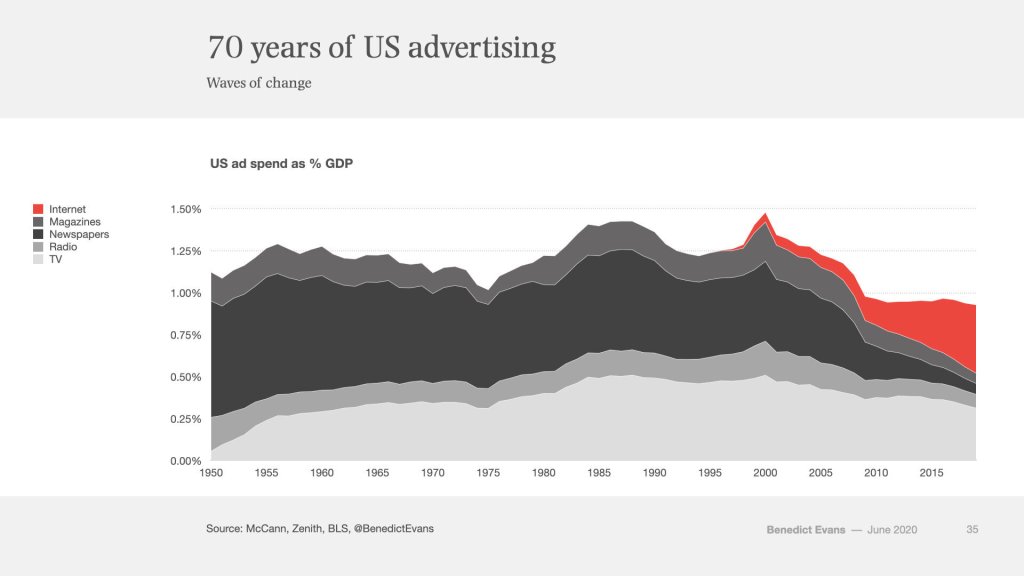:format(webp)/cdn.vox-cdn.com/uploads/chorus_image/image/57064313/Screen_Shot_2015-09-07_at_9.11.34_AM.0.0.png)
Apple’s goal is to sell more hardware, in particular sell more iPhones. That’s where the bulk of Apple’s revenue comes from even today. In order to sell more hardware, Apple wants to commoditize its complements and the biggest complement is apps. The irony is that this decision to destroy the value of software has led directly to their need to crack down on surveillance advertising. The law of unintended consequences at its finest.
How did we get here? This story starts all the way back in the mid-90s when Microsoft launched Windows 95 and Adobe, Pagemaker and Quark decided to support Windows.¹ For years before, Apple had paid huge co-marketing fees to keep these three mammoths of the software publishing business on Mac OS. But Apple’s market share was tiny and the digital publishing business, along with education, were the only two markets still using Macintosh computers. Apple was dying and everyone knew it.
Microsoft came along with Windows 95 and offered a lifeboat to these businesses. Port to Windows and you will be saved. They jumped at the chance.
Apple was the jilted lover and seems to have decided that if it ever survived that mess it would never put itself in that situation again, beholden to software companies. Instead, it would ensure that no one software company could ever get big enough and powerful enough to hurt Apple again.
25 years later and Apple of course is the largest company in the world, and has leveraged its dominant position in the technology industry to ensure no software company could ever challenge them again.
So Apple has been more than happy to see the impact of the App Store, and has been more than a willing participant in devaluing mobile software. Prices in the Palm OS and Windows Mobile days? Shareware titles were $20-30, commercial titles were $50 and more. My own products ranged in price from $10-$160 with our best products at $60. Average price was $37 net with most sales going through our website where we collected contact information and promoted upgrades.
In the iOS days? Prices started at $10 and quickly dropped from there. Within a year average prices were in the $1 range (before Apple took 30%) and most apps were free. The same apps I sold for $60+ on Palm and Windows Mobile were selling for $3.50 net on iOS with all sales going through Apple, no customer data, and no upgrades.
This helped sell lots of iPhones. All this cheap software made Apple’s hardware all the more valuable (commoditizing its complements). And Apple did little to help raise the price. No upgrade pricing, no trial versions, lax App Store policies. If your product failed, oh well for you as there were 100s of others willing to take your place.
The problem is all this cheap software required a business plan to make real money. If developers couldn’t make a living actually selling software, then they would make money selling you. They tracked your location, sharing information with the highest bidder. Because the income to stay in business had to come from somewhere and it wasn’t coming from selling software. Welcome to the surveillance advertising business.
(This is where I want to point out that I never did this and thus work full-time for someone else. Not every company did this and I’m in awe of those who made it through, survived this insanity, and still were able to build indie businesses.)
Even if these developers charged an up-front or subscription price, there was no mechanism to advertise and find out if someone purchased. While Apple could easily provide this capability, they don’t. So developers tracked consumers using the same mechanisms utilized in surveillance advertising. How will developers know if their advertising works now that tracking has been eliminated?
Now Apple cracks down on the surveillance advertising industry, blaming Facebook and others for the intrusion. Is Facebook to blame? Of course. But Apple is no innocent bystander in this insanity to track everything you do and everywhere you go in the name of selling you more crap.
Is Apple wrong to crack down on all this tracking? Of course not. It’s an abhorrent practice that should go away. But let’s not pretend that Apple’s App Store approach and policies hasn’t led us to this exact spot. The two go hand in hand.
¹ I know this story because a former Apple executive told it to me many many years ago.

